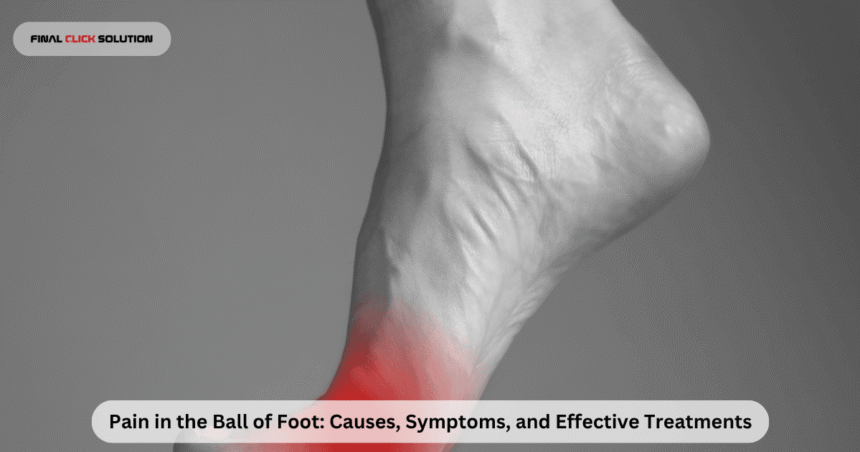Foot pain is one of the most common complaints among adults, and one of the most overlooked types is pain in the ball of the foot—a condition that can disrupt your ability to walk, stand, or enjoy your daily activities. Whether you’re an athlete, someone who wears high heels frequently, or simply spend long hours on your feet, discomfort in this area can develop for a variety of reasons.
In this detailed guide, we’ll explore what causes pain in the ball of the foot, how to identify its symptoms, when to seek medical attention, and the best treatments and preventive measures to help you get back on your feet—comfortably and confidently.
Understanding the Ball of the Foot
The ball of your foot refers to the padded area on the bottom of your foot, just behind your toes. Anatomically, it’s known as the metatarsal region, composed of five long bones called metatarsals that connect the toes to the midfoot. These bones play a crucial role in supporting your body weight and absorbing shock when you walk, run, or jump.
When you put excessive pressure on this area or the surrounding tissues become irritated, inflammation or injury can occur—resulting in pain, tenderness, or even swelling. This type of pain is medically referred to as metatarsalgia, though it can also stem from other underlying conditions.
Common Causes of Pain in the Ball of the Foot
Several factors can contribute to discomfort or inflammation in this region. Understanding the underlying cause is key to effective treatment.
1. Metatarsalgia
Metatarsalgia is a general term for pain and inflammation in the metatarsal region. It’s often caused by overuse, wearing ill-fitting shoes, or participating in high-impact sports like running or basketball. The pain may feel like a sharp ache or burning sensation beneath the toes, especially during walking or standing.
2. Morton’s Neuroma
This is a condition that involves the thickening of tissue around one of the nerves leading to your toes—most commonly between the third and fourth toes. The result is a burning pain in the ball of your foot, often accompanied by numbness or the feeling of a pebble stuck under your shoe. Morton’s neuroma is frequently linked to tight or narrow footwear and repetitive stress.
3. Sesamoiditis
The sesamoid bones are two small bones located beneath the big toe joint. When these bones or surrounding tendons become inflamed—often from repetitive pressure or strain—it can lead to sesamoiditis, characterized by localized pain under the big toe area.
4. Calluses or Hard Skin
Thickened skin can develop due to friction or pressure on the ball of your foot. While calluses themselves aren’t dangerous, the extra thickness can lead to discomfort or even cracking, which exacerbates pain and tenderness.
5. Improper Footwear
Shoes that don’t fit well—especially high heels, narrow dress shoes, or those with little arch support—can put excessive stress on the metatarsal bones. Over time, this imbalance leads to inflammation, muscle fatigue, and chronic pain in the ball of the foot.
6. Arthritis or Joint Inflammation
Rheumatoid arthritis, gout, and osteoarthritis can all cause pain in the ball of the foot. These inflammatory conditions affect the joints and soft tissues, resulting in swelling, stiffness, and reduced mobility.
7. Overuse or High-Impact Activities
Athletes, dancers, or anyone who engages in repetitive jumping or running may experience pain from constant stress on the metatarsals. Without adequate rest or proper footwear, microtrauma accumulates, leading to chronic inflammation.
8. Foot Deformities
Conditions like bunions, hammertoes, or fallen arches alter the distribution of pressure across the foot. This imbalance can cause localized pain in the ball of the foot as some areas absorb more stress than others.
9. Obesity or Sudden Weight Gain
Carrying extra body weight increases the load on your feet, particularly the forefoot region. Over time, this additional pressure can contribute to persistent pain and fatigue.
10. Diabetes and Nerve Issues
People with diabetes may develop neuropathy, which causes nerve damage and altered sensation in the feet. This can make them more prone to foot injuries, ulcers, or inflammation in the ball of the foot area.
Common Symptoms to Watch For
Pain in the ball of your foot can vary in intensity and character, depending on the cause. However, some common signs include:
- Sharp, burning, or aching pain under the toes
- Pain that worsens when standing, walking, or running
- A sensation of having a pebble or small stone inside your shoe
- Numbness or tingling in the toes
- Swelling, redness, or inflammation in the affected area
- Discomfort when wearing tight or high-heeled shoes
If your symptoms persist for more than a few days or interfere with daily activities, it’s important to consult a healthcare provider for a professional diagnosis.
How Pain in the Ball of the Foot Is Diagnosed
A doctor or podiatrist will begin by reviewing your medical history and examining your foot. They may:
- Inspect your footwear to see if improper support or pressure points are causing discomfort.
- Check your gait to evaluate how you walk and distribute weight across your foot.
- Palpate (press) the area to identify points of tenderness or swelling.
- Order imaging tests like X-rays, ultrasound, or MRI scans to rule out fractures, arthritis, or soft tissue injuries.
A precise diagnosis ensures you get the right treatment for long-term relief.
Treatment Options for Pain in the Ball of the Foot
Treatment depends on the root cause of your discomfort. Fortunately, most cases can be managed with non-surgical approaches.
1. Rest and Activity Modification
If your pain stems from overuse or repetitive strain, rest is key. Avoid high-impact activities like running or jumping for a few days and allow your foot to recover.
2. Footwear Changes
Switching to shoes with good arch support, ample cushioning, and wide toe boxes can significantly reduce pressure on the metatarsals. Avoid heels higher than 2 inches and opt for shoes with shock-absorbing soles.
3. Orthotic Inserts
Custom or over-the-counter orthotics can help redistribute pressure evenly across your foot, providing extra support and relief from pain. Metatarsal pads or cushioned insoles are especially helpful for those with flat feet or fallen arches.
4. Ice Therapy
Applying ice packs for 15–20 minutes several times a day can help reduce inflammation and numb the area, providing temporary relief.
5. Pain Relief Medications
Over-the-counter nonsteroidal anti-inflammatory drugs (NSAIDs) like ibuprofen or naproxen can ease pain and swelling. However, these should be used under medical guidance, especially for long-term use.
6. Physical Therapy
A physical therapist may recommend stretching and strengthening exercises to improve foot alignment, flexibility, and strength. This helps correct biomechanical imbalances that contribute to chronic pain.
7. Callus Care
If thick skin or calluses are aggravating the pain, a podiatrist can safely remove the buildup and advise on proper foot care to prevent recurrence.
8. Injections
For severe inflammation, corticosteroid injections may be used to reduce swelling and pain, especially in cases like Morton’s neuroma.
9. Surgical Intervention
Surgery is usually considered a last resort when conservative treatments fail. Procedures may involve removing inflamed tissue, releasing nerve compression, or correcting deformities.
Prevention: Keeping Your Feet Healthy and Pain-Free
Preventing pain in the ball of your foot starts with good foot habits and proper footwear. Here are some preventive measures you can take:
- Wear supportive shoes designed for your activity level and foot type.
- Avoid prolonged use of high heels or narrow-toed shoes.
- Maintain a healthy weight to minimize stress on your feet.
- Stretch regularly to maintain flexibility in your calves, ankles, and feet.
- Replace worn-out shoes promptly, especially if you’re an active walker or runner.
- Use metatarsal pads if you experience recurring pain or pressure.
- Warm up before exercising and gradually increase activity intensity.
When to See a Doctor
You should seek medical advice if:
- The pain persists for more than a week despite rest and home care.
- You experience severe swelling, bruising, or inability to bear weight.
- Numbness, tingling, or sharp burning pain develops in the toes.
- You have diabetes and notice changes in foot sensation or wounds.
Ignoring persistent pain can worsen the condition or lead to long-term joint problems. Early diagnosis and treatment are key to recovery.
Living Comfortably With Foot Pain
Living with chronic foot discomfort can affect not only your mobility but also your overall quality of life. The good news is that most causes of pain in the ball of the foot are treatable with consistent care, proper footwear, and lifestyle adjustments.
Making small but meaningful changes—like using cushioned insoles, taking breaks from standing, and performing simple stretching exercises—can go a long way in restoring comfort.
For those with specific conditions like Morton’s neuroma or arthritis, working closely with a podiatrist or orthopedic specialist ensures that you receive personalized treatment that targets the root cause of your pain.
Final Thoughts
Pain in the ball of the foot may seem minor at first, but if left untreated, it can severely impact your ability to move comfortably. From overuse injuries and footwear issues to structural deformities and nerve irritation, the underlying causes are diverse—but so are the treatment options.
By understanding your symptoms, addressing the root cause, and taking preventive steps, you can protect your feet from long-term damage and maintain an active, pain-free lifestyle.






